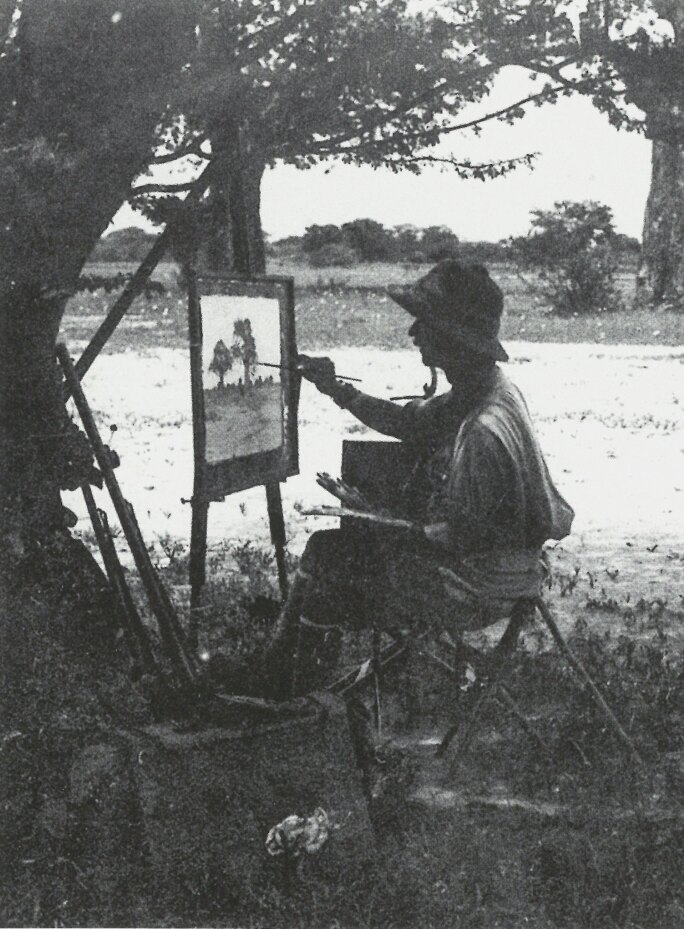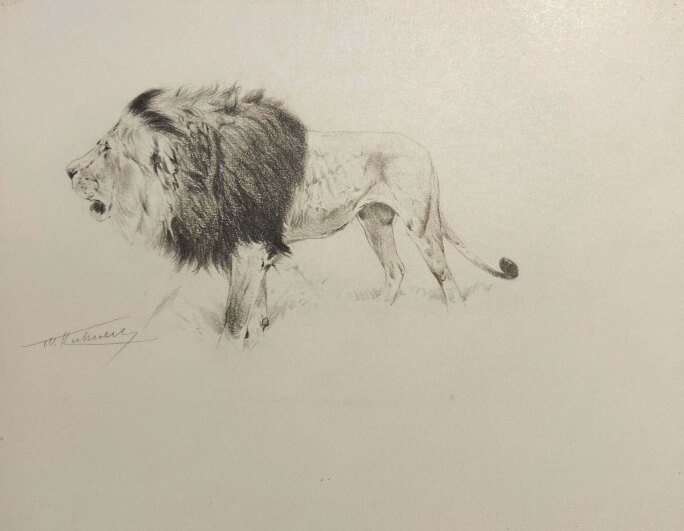
In the late nineteenth century, any young artist interested in painting animal subjects was encouraged to visit one of the many zoos which were fast becoming popular across Europe. The zoos of Dresden and Berlin were by far the most well-known and had provided "models" for many important German animal painters such as Paul Meyerheim, who was Wilhelm Kuhnert’s teacher. While capturing the exotic appeal of lions, tigers, leopards, and other creatures, the resulting works were often based on aged or sickly animals, and the painted African landscapes they inhabited were the result of pure imagination. Dissatisfied with these methods, Kuhnert followed the example of Germany’s celebrated animal painter Richard Friese, who advocated the study of wild animals in their native habitats. In 1891, Kuhnert would become one of the first European artists to travel to the German colonies of East Africa (present day Tanzania, Burundi, Rwanda, and part of Mozambique), where he made oil and pencil sketches of the wildlife and terrain. Upon his return to his Berlin studio, he used those sketches to create his panoramic paintings of the savanna (fig. 1, 2). By the early 1900s, demand for his impressive depictions led Kuhnert to return to the German colonies, as well as the British territory of Sudan, on expeditions that lasted months or over a year. By then, he had refined his working process in order to create powerful works like Auf der Suche nach Beute (In Search for Prey), painted circa 1917, after his fourth and final trip.

Of all of Kuhnert’s animal subjects, lions were a particular favorite, and his deep connection with the animal earned him the nickname "Lion-Kuhnert." While ultimately making around 1,000 sketches, drawings, and paintings of the animal, his first encounter with one took months to complete. As he noted in his diaries one evening, his rest was interrupted by the animals “roaring all night— there must have been at least five of them— would not let me get to sleep.” 1 These memories informed masterful compositions like Auf der Suche nach Beute where Kuhnert places the great maned lion in a moonlit savannah as it hunts. The panoramic perspective suggests the stoic, solitary pursuit of the animal and elevates its iconicism. At the same time, Kuhnert's realist technique powerfully captures finerdetails, notably the subtle variations of color and texture of the great cat’s coat contrasted with the dry, bent grasses and shifting blues of the night sky.
Throughout Kuhnert’s lifetime, his compositions were eagerly sought after by collectors throughout Europe and the United States. By the early twentieth century, the artist’s wildlife paintings were reproduced in natural history books, advertisements, school publications, and scientific texts; his work shaped a popular understanding of the wildlife, landscape, and culture of Africa. More recently, Kuhnert’s powerful imagery and its cultural influence was at the center of the Schirn Kunsthalle’s Frankfurt exhibition King of the Animals, Wilhelm Kuhnert and the Image of Africa (October 2018-January 2019) which brought new insight into this fascinating artist and his subject.
1 Wilhelm Kuhnert diary entry, April 24, 1906 as quoted in Philipp Demandt, “Painting here is no simple matter,” Wilhelm Kuhnert Seen through the Mirror of his Times— and Diaries” in King of the Animals, Wilhelm Kuhnert and the Image of Africa, exhibition catalogue, Schim Kunsthalle, Frankfurt, 2018, p. 27.